Wireless Communication is the fastest growing and most vibrant technological areas in the communication field. Wireless Communication is a method of transmitting information from one point to other, without using any connection like wires, cables or any physical medium.
Generally, in a communication system, information is transmitted from transmitter to receiver that are placed over a limited distance. With the help of Wireless Communication, the transmitter and receiver can be placed anywhere between few meters (like a T.V. Remote Control) to few thousand kilometres (Satellite Communication).
We live in a World of communication and Wireless Communication, in particular is a key part of our lives. Some of the commonly used Wireless Communication Systems in our day – to – day life are: Mobile Phones, GPS Receivers, Remote Controls, Bluetooth Audio and Wi-Fi etc.
What is Wireless Communication?
Communication Systems can be Wired or Wireless and the medium used for communication can be Guided or Unguided. In Wired Communication, the medium is a physical path like Co-axial Cables, Twisted Pair Cables and Optical Fiber Links etc. which guides the signal to propagate from one point to other.
Such type of medium is called Guided Medium. On the other hand, Wireless Communication doesn’t require any physical medium but propagates the signal through space. Since, space only allows for signal transmission without any guidance, the medium used in Wireless Communication is called Unguided Medium. If there is no physical medium, then how does wireless communication transmit signals? Even though there are no cables used in wireless communication, the transmission and reception of signals is accomplished with Antennas.
Antennas are electrical devices that transform the electrical signals to radio signals in the form of Electromagnetic (EM) Waves and vice versa. These Electromagnetic Waves propagates through space. Hence, both transmitter and receiver consists of an antenna.
What are Electromagnetic Waves?
Electromagnetic Waves carry the electromagnetic energy of electromagnetic field through space. Electromagnetic Waves include Gamma Rays (γ – Rays), X – Rays, Ultraviolet Rays, Visible Light, Infrared Rays, Microwave Rays and Radio Waves. Electromagnetic Waves (usually Radio Waves) are used in wireless communication to carry the signals.
An Electromagnetic Wave consists of both electric and magnetic fields in the form of time varying sinusoidal waves. Both these fields are oscillating perpendicular to each other and the direction of propagation of the Electromagnetic Wave is again perpendicular to both these fields.
Mathematically, an Electromagnetic Wave can be described using Maxwell’s equations. Pictorial representation of an Electromagnetic Wave is shown below where the Electric Field is acting in the Y – axis, magnetic field is acting in the Z – axis and the Electromagnetic Wave propagates in X – axis.
Brief History
Since the use of smoke signals, flags and flashing mirrors in the pre – historic period, Wireless communication has been a part of human life and is continuously evolving. Modern Wireless Communication i.e. using electrical signals and radio waves for communication has been around us for more than 100 years.
In the year 1897, Guglielmo Marconi successfully demonstrated the Wireless Telegraphy by sending EM Waves for a short distance of 100 meters. This demonstration paved way for Radio Communication and the term Radio is derived from Radiant Energy.
By early 1900’s, Trans – Atlantic radio transmission had been established, where Marconi successfully transmitted messages in the form of Morse code. Since then, the technology related to wireless communication and wireless system has advanced rapidly and thus enabling transmissions over longer distances at low cost with cheaper devices.
Throughout the development of wireless communication, there are many wireless systems and methods that flourished and many got disappeared. The best example for this is Telephone Communication and Television Transmission. Initially, all telephone related communication was carried out (and still is) using wired network. But the rapid growth of Mobile Communication started to replace the complex wired telephone system. In this scenario, the wired technology became outdated and got replaced by wireless communication. Another scenario where wireless communication got replaced by wired communication is Television broadcasting. In the early days, television signals were broadcasted using wireless radio transmitters. But this setup got replaced by cable television.
These two examples point out that with the development of technology, we always have to choose what’s best for the situation i.e. in some areas we have to use wired communication whereas in the other, going for wireless may be a better option.
Why Wireless Communication?
When wired communication can do most of the tasks that a wireless communication can, why do we need Wireless Communication? The primary and important benefit of wireless communication is mobility. Apart from mobility, wireless communication also offers flexibility and ease of use, which makes it increasingly popular day – by – day. Wireless Communication like mobile telephony can be made anywhere and anytime with a considerably high throughput performance. Another important point is infrastructure. The setup and installation of infrastructure for wired communication systems is an expensive and time consuming job. The infrastructure for wireless communication can be installed easily and low cost. In emergency situations and remote locations, where the setup of wired communication is difficult, wireless communication is a viable option.
Advantages
There are numerous advantage of Wireless Communication Technology, Wireless Networking and Wireless Systems over Wired Communication like Cost, Mobility, Ease of Installation, and Reliability etc.
- Cost – The cost of installing wires, cables and other infrastructure is eliminated in wireless communication and hence lowering the overall cost of the system compared to wired communication system. Installing wired network in building, digging up the Earth to lay the cables and running those wires across the streets is extremely difficult, costly and time consuming job. In historical buildings, drilling holes for cables is not a best idea as it destroys the integrity and importance of the building. Also, in older buildings with no dedicated lines for communication, wireless communication like Wi-Fi or Wireless LAN is the only option.
- Mobility – As mentioned earlier, mobility is the main advantage of wireless communication system. It offers the freedom to move around while still connected to network.
- Ease of Installation – The setup and installation of wireless communication network’s equipment and infrastructure is very easy as we need not worry about the hassle of cables. Also, the time required to setup a wireless system like a Wi-Fi network for example, is very less when compared to setting up a full cabled network.
- Reliability – Since there are no cables and wires involved in wireless communication, there is no chance of communication failure due to damage of these cables which may be caused by environmental conditions, cable splice and natural diminution of metallic conductors.
- Disaster Recovery – In case of accidents due to fire, floods or other disasters, the loss of communication infrastructure in wireless communication system can be minimal.
Disadvantages
Even though wireless communication has a number of advantages over wired communication, there are a few disadvantages as well. The most concerning disadvantages are Interference, Security and Health.
- Interference – Wireless Communication systems use open space as the medium for transmitting signals. As a result, there is a huge chance that radio signals from one wireless communication system or network might interfere with other signals. The best example is Bluetooth and Wi-Fi (WLAN). Both these technologies use the 2.4GHz frequency for communication and when both of these devices are active at the same time, there is a chance of interference.
- Security – One of the main concerns of wireless communication is Security of the data. Since the signals are transmitted in open space, it is possible that an intruder can intercept the signals and copy sensitive information.
- Health Concerns – Continuous exposure to any type of radiation can be hazardous. Even though the levels of RF energy that can cause the damage are not accurately established, it is advised to avoid RF radiation to the maximum.
Basic Elements of a Wireless Communication System
A typical Wireless Communication System can be divided into three elements: the Transmitter, the Channel and the Receiver. The following image shows the block diagram of wireless communication system.
The Transmission Path - 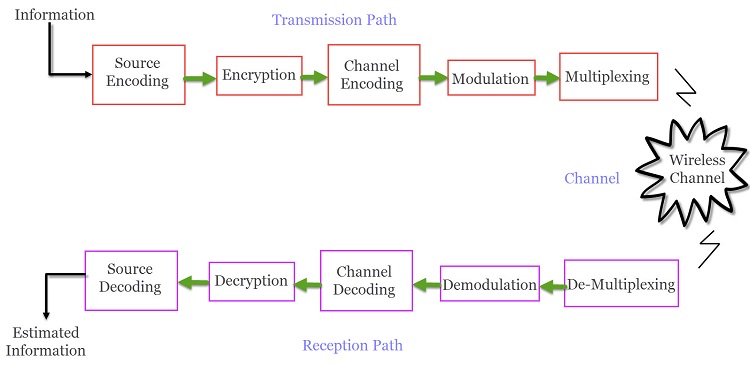 A typical transmission path of a Wireless Communication System consists of Encoder, Encryption, Modulation and Multiplexing. The signal from the source is passed through a Source Encoder, which converts the signal in to a suitable form for applying signal processing techniques.
A typical transmission path of a Wireless Communication System consists of Encoder, Encryption, Modulation and Multiplexing. The signal from the source is passed through a Source Encoder, which converts the signal in to a suitable form for applying signal processing techniques.
The redundant information from signal is removed in this process in order to maximize the utilization of resources. This signal is then encrypted using an Encryption Standard so that the signal and the information is secured and doesn’t allow any unauthorized access.
Channel Encoding is a technique that is applied to the signal to reduce the impairments like noise, interference, etc. During this process, a small amount of redundancy is introduced to the signal so that it becomes robust against noise. Then the signal is modulated using a suitable Modulation Technique (like PSK, FSK and QPSK etc.) , so that the signal can be easily transmitted using antenna.
The modulated signal is then multiplexed with other signals using different Multiplexing Techniques like Time Division Multiplexing (TDM) or Frequency Division Multiplexing (FDM) to share the valuable bandwidth.
The Channel - The channel in Wireless Communication indicates the medium of transmission of the signal i.e. open space. A wireless channel is unpredictable and also highly variable and random in nature. A channel maybe subject to interference, distortion, noise, scattering etc. and the result is that the received signal may be filled with errors.
The Reception Path - The job of the Receiver is to collect the signal from the channel and reproduce it as the source signal. The reception path of a Wireless Communication System comprises of Demultiplexing , Demodulation, Channel Decoding, Decryption and Source Decoding. From the components of the reception path it is clear that the task of the receiver is just the inverse to that of transmitter.
The signal from the channel is received by the Demultiplexer and is separated from other signals. The individual signals are demodulated using appropriate Demodulation Techniques and the original message signal is recovered. The redundant bits from the message are removed using the Channel Decoder.
Since the message is encrypted, Decryption of the signal removes the security and turns it into simple sequence of bits. Finally, this signal is given to the Source Decoder to get back the original transmitted message or signal.
Wireless Communication: Types of Communication Systems
Today, people need Mobile Phones for many things like talking, internet, multimedia etc. All these services must be made available to the user on the go i.e. while the user is mobile. With the help of these wireless communication services, we can transfer voice, data, videos, images etc.
Wireless Communication Systems also provide different services like video conferencing, cellular telephone, paging, TV, Radio etc. Due to the need for variety of communication services, different types of Wireless Communication Systems are developed. Some of the important Wireless Communication Systems available today are:
- Television and Radio Broadcasting
- Satellite Communication
- Radar
- Mobile Telephone System (Cellular Communication)
- Global Positioning System (GPS)
- Infrared Communication
- WLAN (Wi-Fi)
- Bluetooth
- Paging
- Cordless Phones
- Radio Frequency Identification (RFID)
There are many other system with each being useful for different applications. Wireless Communication systems can be again classified as Simplex, Half Duplex and Full Duplex. Simplex communication is one way communication. An example is Radio broadcast system.
Half Duplex is two way communication but not simultaneous one. An example is walkie – talkie (civilian band radio). Full Duplex is also two way communication and it is a simultaneous one. Best example for full duplex is mobile phones.
The devices used for Wireless Communication may vary from one service to other and they may have different size, shape, data throughput and cost. The area covered by a Wireless Communication system is also an important factor. The wireless networks may be limited to a building, an office campus, a city, a small regional area (greater than a city) or might have global coverage.
We will see a brief note about some of the important Wireless Communication Systems.
Television and Radio BroadcastingRadio is considered to be the first wireless service to be broadcast. It is an example of a Simplex Communication System where the information is transmitted only in one direction and all the users receiving the same data.
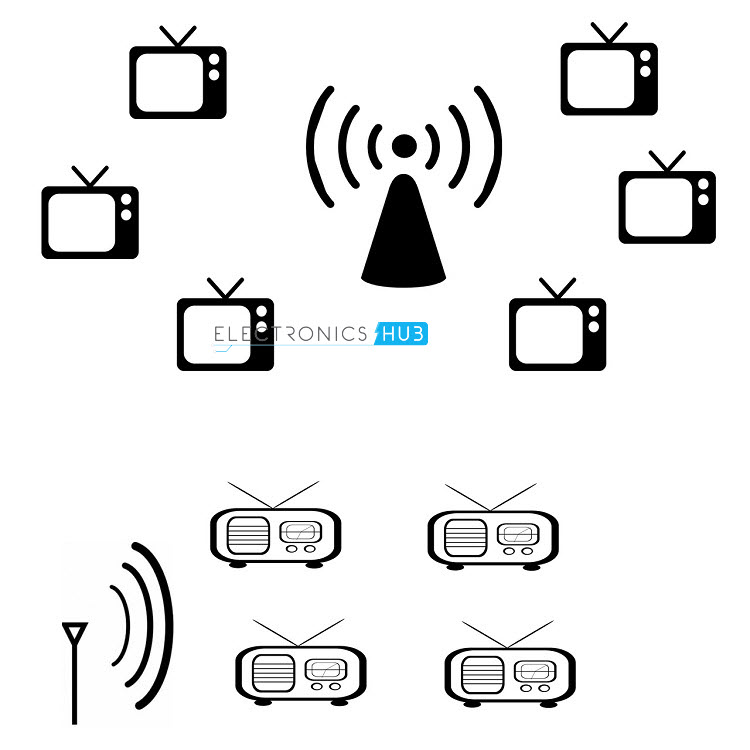 Satellite Communication
Satellite Communication
Satellite Communication System is an important type of Wireless Communication. Satellite Communication Networks provide worldwide coverage independent to population density.
Satellite Communication Systems offer telecommunication (Satellite Phones), positioning and navigation (GPS), broadcasting, internet, etc. Other wireless services like mobile, television broadcasting and other radio systems are dependent of Satellite Communication Systems.
Mobile Telephone Communication SystemPerhaps, the most commonly used wireless communication system is the Mobile Phone Technology. The development of mobile cellular device changed the World like no other technology. Today’s mobile phones are not limited to just making calls but are integrated with numerous other features like Bluetooth, Wi-Fi, GPS, and FM Radio.
Global Positioning System (GPS)GPS is solely a subcategory of satellite communication. GPS provides different wireless services like navigation, positioning, location, speed etc. with the help of dedicated GPS receivers and satellites.
BluetoothBluetooth is another important low range wireless communication system. It provides data, voice and audio transmission with a transmission range of 10 meters. Almost all mobile phones, tablets and laptops are equipped with Bluetooth devices. They can be connected to wireless Bluetooth receivers, audio equipment, cameras etc.
PagingAlthough it is considered an obsolete technology, paging was a major success before the wide spread use of mobile phones. Paging provides information in the form of messages and it is a simplex system i.e. the user can only receive the messages.
Wireless Local Area Network (WLAN)Wireless Local Area Network or WLAN (Wi-Fi) is an internet related wireless service. Using WLAN, different devices like laptops and mobile phones can connect to an access point and access internet.
Infrared CommunicationInfrared Communication is another commonly used wireless communication in our daily lives. It uses the infrared waves of the Electromagnetic (EM) spectrum. Infrared (IR) Communication is used in remote controls of Televisions, cars, audio equipment etc.







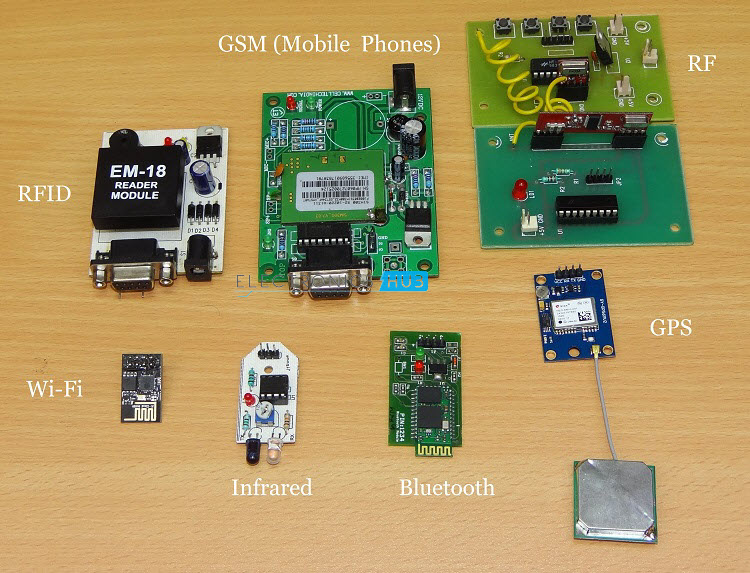
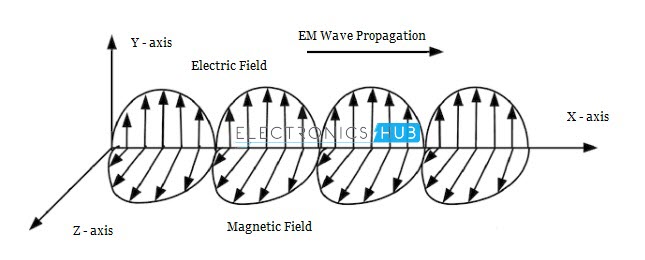

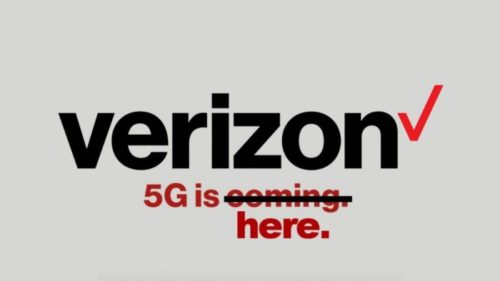

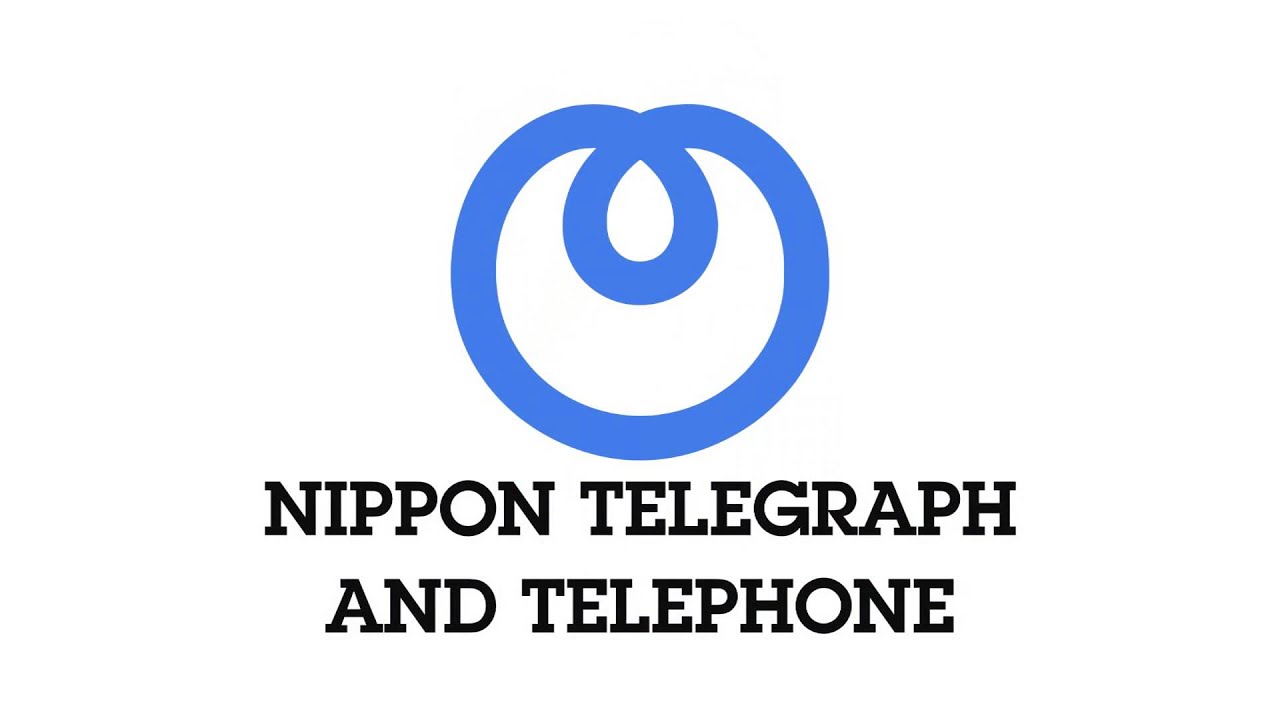







Leave a Reply